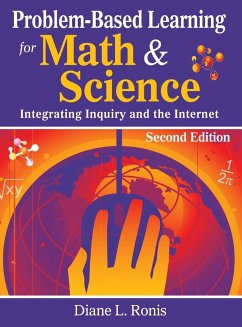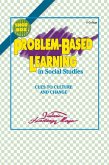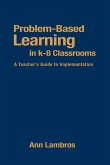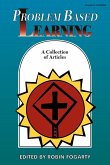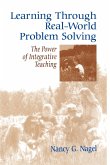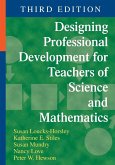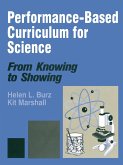Schade – dieser Artikel ist leider ausverkauft. Sobald wir wissen, ob und wann der Artikel wieder verfügbar ist, informieren wir Sie an dieser Stelle.
- Gebundenes Buch
- Merkliste
- Auf die Merkliste
- Bewerten Bewerten
- Teilen
- Produkt teilen
- Produkterinnerung
- Produkterinnerung
Illustrates how to strengthen learners' problem-solving skills by incorporating problem-based learning (PBL) with Internet resources and presents projects that correlate to national science, mathematics, and technology standards.
Andere Kunden interessierten sich auch für
![Problem-Based Learning in Social Studies Problem-Based Learning in Social Studies]() Valerie Hastings MoyeProblem-Based Learning in Social Studies28,99 €
Valerie Hastings MoyeProblem-Based Learning in Social Studies28,99 €![Math-Ish Math-Ish]() Jo BoalerMath-Ish20,99 €
Jo BoalerMath-Ish20,99 €![Problem-Based Learning in K-8 Classrooms Problem-Based Learning in K-8 Classrooms]() Ann LambrosProblem-Based Learning in K-8 Classrooms24,99 €
Ann LambrosProblem-Based Learning in K-8 Classrooms24,99 €![Problem Based Learning Problem Based Learning]() Robin J. Fogarty (ed.)Problem Based Learning38,99 €
Robin J. Fogarty (ed.)Problem Based Learning38,99 €![Learning Through Real-World Problem Solving Learning Through Real-World Problem Solving]() Nancy G. NagelLearning Through Real-World Problem Solving32,99 €
Nancy G. NagelLearning Through Real-World Problem Solving32,99 €![Designing Professional Development for Teachers of Science and Mathematics Designing Professional Development for Teachers of Science and Mathematics]() Katherine E StilesDesigning Professional Development for Teachers of Science and Mathematics41,99 €
Katherine E StilesDesigning Professional Development for Teachers of Science and Mathematics41,99 €![Performance-Based Curriculum for Science Performance-Based Curriculum for Science]() Helen L. BurzPerformance-Based Curriculum for Science27,99 €
Helen L. BurzPerformance-Based Curriculum for Science27,99 €-
-
Illustrates how to strengthen learners' problem-solving skills by incorporating problem-based learning (PBL) with Internet resources and presents projects that correlate to national science, mathematics, and technology standards.
Produktdetails
- Produktdetails
- Verlag: Corwin
- 2. Auflage
- Seitenzahl: 176
- Erscheinungstermin: 12. September 2007
- Englisch
- Abmessung: 286mm x 221mm x 14mm
- Gewicht: 719g
- ISBN-13: 9781412955584
- ISBN-10: 1412955580
- Artikelnr.: 22802075
- Herstellerkennzeichnung
- Libri GmbH
- Europaallee 1
- 36244 Bad Hersfeld
- gpsr@libri.de
- Verlag: Corwin
- 2. Auflage
- Seitenzahl: 176
- Erscheinungstermin: 12. September 2007
- Englisch
- Abmessung: 286mm x 221mm x 14mm
- Gewicht: 719g
- ISBN-13: 9781412955584
- ISBN-10: 1412955580
- Artikelnr.: 22802075
- Herstellerkennzeichnung
- Libri GmbH
- Europaallee 1
- 36244 Bad Hersfeld
- gpsr@libri.de
Diane Ronis is a professor of education at Southern Connecticut State University and has a Ph.D. in curriculum and instruction. Her drive to make learning meaningful to all students comes from 17 years of teaching middle school and high school mathematics and fine arts as well as eight years of experience instructing preservice teachers at the college and graduate level. Ronis has been a presenter and keynote speaker at numerous conferences, workshops and seminars, and is the author of Brain Compatible Mathematics, Brain Compatible Assessments, Critical Thinking in Math, Problem Based Learning for Math & Science: Integrating Inquiry and the Internet, and Clustering Standards in Integrated Units.
Preface
Introduction
The Concepts Explored in This Book
The Standards Used in This Book
The Goal of This Book
1. The Integration of Mathematics, Science, Technology, and Problem-Based
Learning
Redefining Literacy
Using Problem-Based Learning to Increase Literacy
Relating Technology to Math and Science
Integrating Problem-Based Learning With Cyber-Age Math and Science
Integrated Inquiry Project, Middle Level: Meteorology
2. Problem-Based Learning and Constructivism
Why Problem-Based Learning Is Brain-Compatible
Problem-Based Learning and the Constructivist Model: The Five E¿s
Teaching in the Problem-Based Learning Classroom
Integrated Inquiry Project, Middle/Secondary Level: Developing
Entrepreneurial Excellence
3. Aspects and Approaches of Problem-Based Learning
Phases of Implementation
Problem-Based Learning Techniques
New Roles for Teachers
Integrated Inquiry Project 1: Middle/Secondary Levels: The Roller Coaster
Integrated Inquiry Project 2: Secondary Level: Building Bridges
4. Planning Problem-Based Learning for the Classroom
Planning for Integrated Learning
Guidelines for Implementing a Problem-Based Learning Project
Questions to Promote Problem Solving
Integrated Inquiry Project, Multilevel: The Mississippi Delta
5. Evaluating and Assessing Problem-Based Learning
Alternative Assessments
Types of Authentic Assessment and Evaluation
Integrated Inquiry Project, Multilevel: Architectural Design
6. Integrating Community Learning Activities Into the Classroom
The National Association of Partners in Education
Organizational Partnerships in Education
Helping Experts Become Teachers
Community Connections: Multilevel Car Project
Appendix: Cyber Sources for Math, Science, and Technology
Bibliography
Index
Introduction
The Concepts Explored in This Book
The Standards Used in This Book
The Goal of This Book
1. The Integration of Mathematics, Science, Technology, and Problem-Based
Learning
Redefining Literacy
Using Problem-Based Learning to Increase Literacy
Relating Technology to Math and Science
Integrating Problem-Based Learning With Cyber-Age Math and Science
Integrated Inquiry Project, Middle Level: Meteorology
2. Problem-Based Learning and Constructivism
Why Problem-Based Learning Is Brain-Compatible
Problem-Based Learning and the Constructivist Model: The Five E¿s
Teaching in the Problem-Based Learning Classroom
Integrated Inquiry Project, Middle/Secondary Level: Developing
Entrepreneurial Excellence
3. Aspects and Approaches of Problem-Based Learning
Phases of Implementation
Problem-Based Learning Techniques
New Roles for Teachers
Integrated Inquiry Project 1: Middle/Secondary Levels: The Roller Coaster
Integrated Inquiry Project 2: Secondary Level: Building Bridges
4. Planning Problem-Based Learning for the Classroom
Planning for Integrated Learning
Guidelines for Implementing a Problem-Based Learning Project
Questions to Promote Problem Solving
Integrated Inquiry Project, Multilevel: The Mississippi Delta
5. Evaluating and Assessing Problem-Based Learning
Alternative Assessments
Types of Authentic Assessment and Evaluation
Integrated Inquiry Project, Multilevel: Architectural Design
6. Integrating Community Learning Activities Into the Classroom
The National Association of Partners in Education
Organizational Partnerships in Education
Helping Experts Become Teachers
Community Connections: Multilevel Car Project
Appendix: Cyber Sources for Math, Science, and Technology
Bibliography
Index
Preface
Introduction
The Concepts Explored in This Book
The Standards Used in This Book
The Goal of This Book
1. The Integration of Mathematics, Science, Technology, and Problem-Based
Learning
Redefining Literacy
Using Problem-Based Learning to Increase Literacy
Relating Technology to Math and Science
Integrating Problem-Based Learning With Cyber-Age Math and Science
Integrated Inquiry Project, Middle Level: Meteorology
2. Problem-Based Learning and Constructivism
Why Problem-Based Learning Is Brain-Compatible
Problem-Based Learning and the Constructivist Model: The Five E¿s
Teaching in the Problem-Based Learning Classroom
Integrated Inquiry Project, Middle/Secondary Level: Developing
Entrepreneurial Excellence
3. Aspects and Approaches of Problem-Based Learning
Phases of Implementation
Problem-Based Learning Techniques
New Roles for Teachers
Integrated Inquiry Project 1: Middle/Secondary Levels: The Roller Coaster
Integrated Inquiry Project 2: Secondary Level: Building Bridges
4. Planning Problem-Based Learning for the Classroom
Planning for Integrated Learning
Guidelines for Implementing a Problem-Based Learning Project
Questions to Promote Problem Solving
Integrated Inquiry Project, Multilevel: The Mississippi Delta
5. Evaluating and Assessing Problem-Based Learning
Alternative Assessments
Types of Authentic Assessment and Evaluation
Integrated Inquiry Project, Multilevel: Architectural Design
6. Integrating Community Learning Activities Into the Classroom
The National Association of Partners in Education
Organizational Partnerships in Education
Helping Experts Become Teachers
Community Connections: Multilevel Car Project
Appendix: Cyber Sources for Math, Science, and Technology
Bibliography
Index
Introduction
The Concepts Explored in This Book
The Standards Used in This Book
The Goal of This Book
1. The Integration of Mathematics, Science, Technology, and Problem-Based
Learning
Redefining Literacy
Using Problem-Based Learning to Increase Literacy
Relating Technology to Math and Science
Integrating Problem-Based Learning With Cyber-Age Math and Science
Integrated Inquiry Project, Middle Level: Meteorology
2. Problem-Based Learning and Constructivism
Why Problem-Based Learning Is Brain-Compatible
Problem-Based Learning and the Constructivist Model: The Five E¿s
Teaching in the Problem-Based Learning Classroom
Integrated Inquiry Project, Middle/Secondary Level: Developing
Entrepreneurial Excellence
3. Aspects and Approaches of Problem-Based Learning
Phases of Implementation
Problem-Based Learning Techniques
New Roles for Teachers
Integrated Inquiry Project 1: Middle/Secondary Levels: The Roller Coaster
Integrated Inquiry Project 2: Secondary Level: Building Bridges
4. Planning Problem-Based Learning for the Classroom
Planning for Integrated Learning
Guidelines for Implementing a Problem-Based Learning Project
Questions to Promote Problem Solving
Integrated Inquiry Project, Multilevel: The Mississippi Delta
5. Evaluating and Assessing Problem-Based Learning
Alternative Assessments
Types of Authentic Assessment and Evaluation
Integrated Inquiry Project, Multilevel: Architectural Design
6. Integrating Community Learning Activities Into the Classroom
The National Association of Partners in Education
Organizational Partnerships in Education
Helping Experts Become Teachers
Community Connections: Multilevel Car Project
Appendix: Cyber Sources for Math, Science, and Technology
Bibliography
Index

